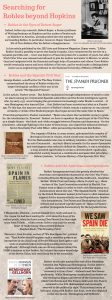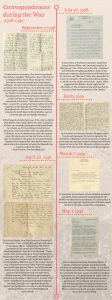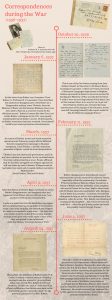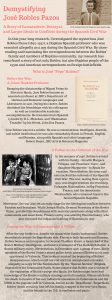
 It has truly been a pleasure to be a Freshman Fellow this year. In the second half of my research, through translations and close-readings, I delved deeper into the correspondence between Jose Robles’ family, trapped in war-torn Spain, and his friends in the U.S. Even now, as I recollect my memories of sitting in the Special Collections Reading Room, and scrutinizing those letters written in wild cursive by a hand from decades ago, I can almost feel on my fingertips the kisses of the dark ink, and the timeless emotions it bespeaks.
It has truly been a pleasure to be a Freshman Fellow this year. In the second half of my research, through translations and close-readings, I delved deeper into the correspondence between Jose Robles’ family, trapped in war-torn Spain, and his friends in the U.S. Even now, as I recollect my memories of sitting in the Special Collections Reading Room, and scrutinizing those letters written in wild cursive by a hand from decades ago, I can almost feel on my fingertips the kisses of the dark ink, and the timeless emotions it bespeaks.
In particular, I recall one moment in my research, when I found myself staring at two letters from Coco, Robles’ son, to Hopkins Professor H. C. Lancaster, a friend and colleague of Robles’. In the letter from January 1937, Coco, confused and helpless, describes the disappearance of his father as a “disagreeable mishap”, for “Nobody … has been able to find out a concrete reason for his ridiculous arrest.” In the letter from April 1940, however, Coco, writing from a Francoist prison in Spain, congratulates Professor Lancaster on his twenty years of service at Hopkins, and says, “Maybe someday I will have the opportunity to stretch out my hands to thank you in person.” In the end, with the generous help of Professor Lancaster and many others, Coco escaped from Spain into Mexico, where he reunited with his family and eventually became a professor at the National University of Mexico. For me, this touching juxtaposition between the two yellowed letters, disjointed in time yet threaded together by the intangible connection between Hopkins and Robles’ family, helped me portray the story of Robles not only as one of tragedy and violence, but also as one of friendship and camaraderie.
 Besides the letters available at Special Collections, I also searched for Robles beyond Hopkins’ campus. During my quest, I discovered traces of Robles in unexpected corners of the world, including a New Yorker article titled “The Spanish Prisoner”, Paul Preston’s book We Saw Spain Die, and excerpts from “Spain in Flames”, a Loyalist war propaganda documentary co-narrated by two great American writers, Ernest Hemingwayand John Dos Passos. Fun fact: there is also a minor character in the 2012 movie, Hemingway and Gellhorn, named Paco Zarra, who is based on Robles. Together, these textual and visual resources helped me place Robles in the context of the Spanish Civil War and particularly within the close-knit community of American Correspondents at the War Front. Robles’ death also marked the end of the friendship between Dos Passos and Hemingway, for the latter’s callous, sarcastic commentary on Robles’ death – “necessary in times of war” – disheartened and disillusioned Dos Passos, who had cherished a long-lasting friendship with Robles.
Besides the letters available at Special Collections, I also searched for Robles beyond Hopkins’ campus. During my quest, I discovered traces of Robles in unexpected corners of the world, including a New Yorker article titled “The Spanish Prisoner”, Paul Preston’s book We Saw Spain Die, and excerpts from “Spain in Flames”, a Loyalist war propaganda documentary co-narrated by two great American writers, Ernest Hemingwayand John Dos Passos. Fun fact: there is also a minor character in the 2012 movie, Hemingway and Gellhorn, named Paco Zarra, who is based on Robles. Together, these textual and visual resources helped me place Robles in the context of the Spanish Civil War and particularly within the close-knit community of American Correspondents at the War Front. Robles’ death also marked the end of the friendship between Dos Passos and Hemingway, for the latter’s callous, sarcastic commentary on Robles’ death – “necessary in times of war” – disheartened and disillusioned Dos Passos, who had cherished a long-lasting friendship with Robles.
These resources also challenged my previous understanding of the Spanish Civil War as a simple binary, as a black-and-white struggle between Fascism and democracy. In fact, the Soviet Comintern, although fighting in the name of democracy, also signed the infamous German-Soviet Neutrality Pact and persecuted many intellectuals. Though it still remains a mystery why Robles was selected for such a sensitive position as interpreter to the local chief of Soviet Military Intelligence, his behind-the-scenes knowledge of the Soviet Union had very likely turned him into a victim of Stalin’s purge in Western Europe.
 Quite obviously, my year-long research has educated me, in terms of both breadth and depth, about the Spanish Civil War, which can also be seen as a “dress rehearsal” for World War II. More importantly, however, I treasure immensely the opportunity to work with primary resources – an intellectual and “tactile” privilege I didn’t enjoy during my research projects in high school. Indeed, as we live in an age of mass digitization when everything, including books, is going online, my own research experience as a Freshman Fellow offers almost a counter-narrative, which brings me back into proximity with not only papers but also a fragment of history that was forgotten by many, but lived painstakingly by a few. Seeing the world with a perhaps romanticized vision, I’d sometimes like to believe that the universe is made of not little molecules, but also countless, little stories. And if anything, my research reaffirms this belief of mine as well as my determination to become a storyteller.
Quite obviously, my year-long research has educated me, in terms of both breadth and depth, about the Spanish Civil War, which can also be seen as a “dress rehearsal” for World War II. More importantly, however, I treasure immensely the opportunity to work with primary resources – an intellectual and “tactile” privilege I didn’t enjoy during my research projects in high school. Indeed, as we live in an age of mass digitization when everything, including books, is going online, my own research experience as a Freshman Fellow offers almost a counter-narrative, which brings me back into proximity with not only papers but also a fragment of history that was forgotten by many, but lived painstakingly by a few. Seeing the world with a perhaps romanticized vision, I’d sometimes like to believe that the universe is made of not little molecules, but also countless, little stories. And if anything, my research reaffirms this belief of mine as well as my determination to become a storyteller.
And of course, throughout my research I have encountered some challenges, especially when it comes to translation and recognizing the cursive handwriting of Robles’ wife and many others. But luckily, with the help of many Hopkins faculty members, including my Spanish professor Naiara Martinez-Velez, I was able to not only interpret and translate the correspondence, but also build around myself a supportive community of Hopkins scholars who, I trust, will provide me with more guidance going forward.
Lastly, it’s my honor to have the opportunity to work alongside my dedicated mentor Jim Stimpert, and three other talented Fellows. Their stories and projects have inspired and motivated me tremendously in the past year. And I’m also glad that the posters I spent days designing (for someone lacking artistic talents like me, alas) will be a little legacy I left at Hopkins, while the hours I spent at the Special Collections, surrounded by books and history, will always be one of my favorite freshman year memories.
— Tiancheng “Tim” Lyu, Freshman Fellow, 2017-2018
